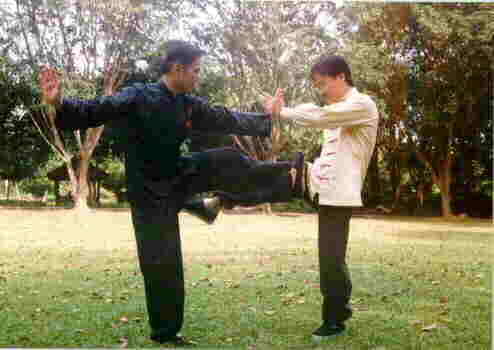TRADITIONAL KUNGFU, MISCELLANEOUS TECHNIQUES AND FREE SPARRING

A thrust kick against a round-house kick
Question
Are roundhouse kicks, hooks and all such following free attacks found in traditional kung fu as well?
-- Kshitij, India
Answer
Some of these attacks are not found in some styles of kungfu. It is not because the kungfu practitioners do not know them, but because these techniques contain innate weaknesses that make their application in combat disadvantageous.
But if opponents use these attacks on the kungfu practitioners, the kungfu practitioners can counter them effectively.
Roundhouse kicks, for example, are not found in Wing Choon Kungfu. But if an opponent were to execute roundhouse kicks on a Wing Choon practitioner, the attacker will be in serious trouble. There are many typical Wing Choon counters against roundhouse kicks.
The practitioner who practices Wing Choon Kungfu, which was invented by an elegant, graceful lady, would not block the roundhouse kicks. But as soon as the attacker kicks, he will find his knee being fractured, his groin being hit, this throat being pierced, or his head being struck from behind.
But all attack and defence techniques in all martial arts, including shoots, take-downs, pin-downs, grabbling, sophisticated locks and throws, are found in Shaolin Kungfu.
Question
Because it is a basic for every art, and I have read about Shaolin san shou where the san shou is called sanda after it is made a sports version but the original sanshou came after studying techniques from Bagua, Taichi, Drunken Boxing, Praying Mantis, Xingyi, Choy Li Fut, Hoong Kuen, Tiger, Monkey etc. I'm sure every style has these hooks, roundhouse kick, etc. types of free techniques.
Answer
San-shou and san-da are not modern inventions. They have been in traditional kungfu for centuries.
Technically san-shou and san-da are different, though some people use the two terms interchangeably.
San-shou means miscellaneous techniques. It refers to using specific counters against specific attacks. If a Muay Thai fighter executes a powerful right sweeping kick at your left ribs, for example, if you practice Monkey Style Kungfu, you will move diagonally forward to your right, squat down and grip your opponent's groin with your left monkey paw using the pattern "Monkey Steals Peach".
If you practice Taijiquan, you will probably use a different counter against the same attack. You step diagonally to your right and kick your opponent's groin with a left thrust kick using the pattern "Cross-Hand Thrust-Kick".
Hence, "Monkey Steals Peach" is a Monkey Style Kungfu san-shou, and "Cross-Hand Thrust-Kick" is a Taijiquan san-shou against a Muay Thai sweeping kick. In either case the kungfu exponent disables the Muay thai fighter as soon as he attacks. And you don't need to make your legs hard to do so.
San-da means miscellaneous fighting or free sparring. In other words, you do not follow a routine as you fight. The attacks come at random. In the past those who practiced Monkey Style Kungfu, naturally would use Monkey Style Kungfu for san-da or free sparring. Those who practiced Taijiquan would use Taijiquan for free sparring. One would use the style of kungfu or martial art he had been trained in for free sparring. But today regardless of what kungfu style they practice, most practitioners use kick-boxing.
LINKS
